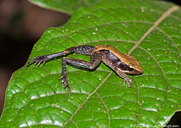|
Description
M 24-26 mm, F 27-33 mm. Tibiotarsal articulation reaches snout tip or beyond. Fifth toe longer than third toe. Femoral glands in males often small and not very prominent. Frenal stripe indistinct, fading under the eye and not continued until nostril. Ventrally often with a dark throat with a light median line. Dorsally often with a diamond-shaped marking (Glaw and Vences 2007). Distribution and Habitat
Country distribution from AmphibiaWeb's database: Madagascar
Species is located in Ambohitantely, Ambolokopatrika corridor, An’Ala, Andasibe, Andavaka, Andrangoloaka, Anjanaharibe, Antsahamanara (Tsaratanana), Antsahamanintsy, Besariaka, Ifanadiana, Ilampy, Lac Alaotra, Mahajeby, Mandraka, Marojejy, Niagarakely, Ranomafana, Tsararano, Vohiparara (Glaw and Vences 2007).
It has been recorded at 600-1500 m asl, but probably also occurs lower than this range (Nussbaum et. al 2008). Life History, Abundance, Activity, and Special Behaviors
Habits: A widespread species along rainforest streams at mid-altitudes throughout Madagascar, although it is less commonly found than M. melanopleura. Males call mostly during the day from concealed positions near the streams (up to 10 m distance), but sometimes also from up to 50 cm high in the vegetation. Single specimens were also found calling at night from 2 m above the ground in bushes. M. opiparis and M. melanopleura often form mixed choruses during the day. Boosts of calling activity are often emitted after longer silence, and these boosts can then run wave-like along the stream (Glaw and Vences 2007).
Calls: Series of 23-35 short pulsed notes. Notes are longer and call series slower than in M. melanopleura (Glaw and Vences 2007).
Trends and Threats
This species is listed as least concern because of its wide distribution, presumed large population, and because it is unlikely to be declining fast enough to qualify for listing in a more threatened category. Though it occurs in many protected areas, its forest habitat is receding due to subsistence agriculture, timber extraction, charcoal manufacture, and invasive spread of eucalyptus, livestock grazing and expanding human settlements (Nussbaum et. al 2008). Possible reasons for amphibian decline General habitat alteration and loss
Habitat modification from deforestation, or logging related activities
Intensified agriculture or grazing
Urbanization
Subtle changes to necessary specialized habitat
Comments
Taken with permission from Glaw and Vences (2007) and Nussbaum et. al (2008).
References
Glaw, F., and Vences, M. (2007). Field Guide to the Amphibians and Reptiles of Madagascar. Third Edition. Vences and Glaw Verlag, Köln.
Nussbaum, R., Glaw, F., and Andreone, F. (2008). Mantidactylus opiparis. In: IUCN 2008. 2008 IUCN Red List of Threatened Species. www.iucnredlist.org. Downloaded on 07 April 2009.
Originally submitted by: Miguel Vences and Frank Glaw (first posted 2000-11-30)
Edited by: Catherine Aguilar (2009-05-01)Species Account Citation: AmphibiaWeb 2009 Mantidactylus opiparis <https://amphibiaweb.org/species/4617> University of California, Berkeley, CA, USA. Accessed May 25, 2025.
Feedback or comments about this page.
Citation: AmphibiaWeb. 2025. <https://amphibiaweb.org> University of California, Berkeley, CA, USA. Accessed 25 May 2025.
AmphibiaWeb's policy on data use.
|
